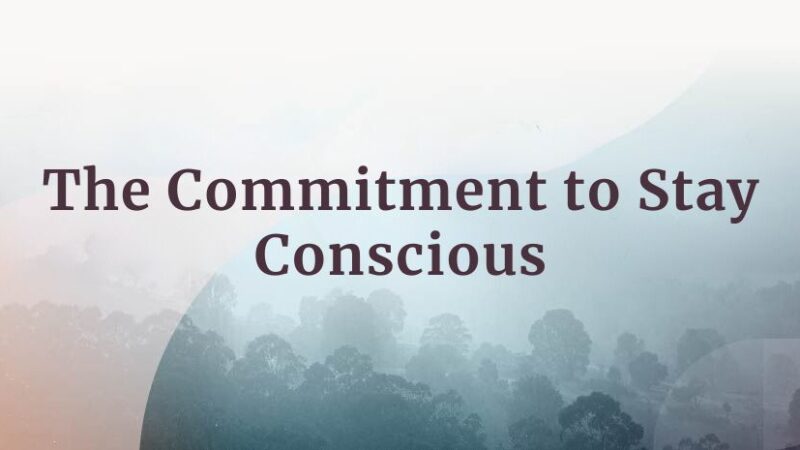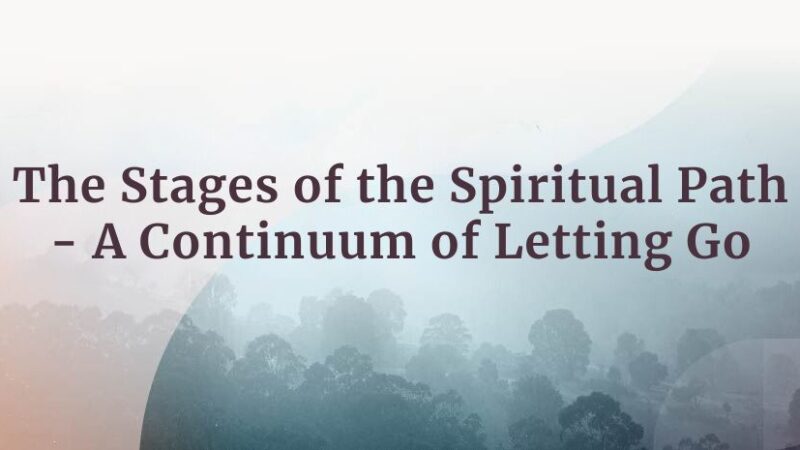-
E117: The Real Work: Letting Go from Within
Michael Singer — October 2, 2025
True spirituality isn’t about mystical experiences or lofty ideals—it’s about honestly facing...
-
Once More: Reflections on Reincarnation and the Gap Between Lives
Tami Simon — September 26, 2025
In this special reflection episode of Insights at the Edge host Tami Simon looks back on her...
-
Honey Tasting Meditation: Build Your Relationship with Sweetness
There is a saying that goes “hurt people hurt people.” I believe this to be true. We have been...
Written by:
Amy Burtaine, Michelle Cassandra Johnson
-
Many Voices, One Journey
The Sounds True Blog
Insights, reflections, and practices from Sounds True teachers, authors, staff, and more. Have a look—to find some inspiration and wisdom for uplifting your day.
Standing Together, and Stepping Up
Written By:
Tami Simon -
The Michael Singer Podcast
Your Highest Intention: Self-Realization
Michael Singer discusses intention—"perhaps the deepest thing we can talk about"—and the path to self-realization.
This Week:
E116: Doing the Best You Can: The Path to Liberation -
Many Voices, One Journey
The Sounds True Blog
Insights, reflections, and practices from Sounds True teachers, authors, staff, and more. Have a look—to find some inspiration and wisdom for uplifting your day.
Take Your Inner Child on Playdates
Written By:
Megan Sherer
600 Podcasts and Counting...
Subscribe to Insights at the Edge to hear all of Tami's interviews (transcripts available, too!), featuring Eckhart Tolle, Caroline Myss, Tara Brach, Jack Kornfield, Adyashanti, and many more.
Most Recent
S2 E3: The Commitment to Stay Conscious
Even when you’ve devoted yourself to spiritual work, it can be difficult to maintain mindful awareness. In this episode, Michael speaks on the difficulty of maintaining consciousness and equanimity when we seem hardwired to be hooked by outside stimuli.
For more information, go to michaelsingerpodcast.com.
© Sounds True Inc. Episodes: © 2024 Michael A. Singer. All Rights Reserved.
Unshakable Inner Peace: What Does That Mean, and Is It...
Shannon Kaiser is the bestselling author of five books on the psychology of happiness and fulfillment, including The Self-Love Experiment, Adventures for Your Soul, and Joy Seeker. As a life coach, international speaker, and retreat leader, she helps people align with their true selves so they can live their highest potential.
In this podcast, Sounds True founder Tami Simon speaks with Shannon about her new book, Return to You, and how we can embrace every part of ourselves and realize “an unshakable inner peace.” They also discuss the spiritual lesson that “if you don’t go within you go without,” identifying your particular intuitive style and tapping your innate wisdom, working with anxiety and shifting from fear to love, the practice of “alchemizing fear” so as not to bypass it, ways to amplify our sense of love and connection, why in order to really know something you must know its opposite, personal expansion and reclaiming your power, how to “turn your resistance into assistance,” cultivating an “activation mindset” to sustain calm, and much more.
S2 E2: The Stages of the Spiritual Path – A Cont...
How do you know when you’re actually walking the path or when you’re just strengthening your ego? Here, Michael considers the gateways to and pitfalls of spiritual work.
For more information, go to michaelsingerpodcast.com.
© Sounds True Inc. Episodes: © 2024 Michael A. Singer. All Rights Reserved.
Customer Favorites
The Basics of Natural Awareness 101: Relaxing Effort

There are three deliberate mental shifts you can make during classical mindfulness meditation that can help point you toward natural awareness: relaxing effort, broadening attention, and dropping objects.
Relaxing Effort
Using effort in classical mindfulness meditation typically means working to bring our attention back to whatever is the present-moment experience. We rigorously and faithfully return our attention to our main focus, typically our breathing. The moment we notice we’ve gotten lost in thought, we deliberately redirect our attention back to our breathing. It can be very hard work. I’ve seen meditators covered in sweat, straining to be aware.
This type of overexertion in meditation is too extreme. In classical mindfulness meditation, we need to be balanced between effort that leads to clear seeing and too much effort that doesn’t really serve us. Some meditators experience a lot of self-judgment, believing that they’re not trying hard enough.
Classical mindfulness meditators typically report that focusing gets easier over time. They can stay aware of their breathing for extended periods, or they find that they return their attention to their breath more quickly when it wanders away. Some people call this ease effortless effort—an experience in our meditation practice where we are making an effort, but it doesn’t seem hard to do at all.
Relaxing effort to shift into natural awareness is a little different. It means that we rein in the tendency to try to put our attention on our breath or other objects, and instead we just be with the objects as they arise.
I think a common concern of many meditators is that if they stop trying, then nothing will happen. Meditators also worry that their mind will wander all over the place if they are not making any effort to do something with it. Well, just sitting down and not doing anything wouldn’t be natural awareness practice; it would be sitting down and doing nothing. So that’s not what we’re trying to do here. Dropping or relaxing effort is very different in that we are tuning in to the awareness that is already present, without trying hard to get there. We also don’t necessarily have a wandering mind because we relax effort on the heels of having worked hard to pay attention.
Think of shifting into natural awareness like riding a bicycle. Often we pedal really hard, but at a certain point, we stop pedaling and begin coasting. The bike stays upright, and we continue to head wherever we’re going, but we’re not working so hard. In fact, it’s usually quite exhilarating to coast on a bicycle. The coasting is dependent upon the earlier pedaling stage, just like effortlessness in meditation is dependent upon the effort you made earlier—particularly the effort to concentrate your mind.
So what does relaxing effort feel like in meditation? It feels like stopping the attempt to wrestle with your unruly mind, to bring it effortfully back to the present, and instead resting, relaxing, and exploring the awareness that is already present. It often feels like things are just happening on their own, and we’re witnessing them. It can feel immensely relaxing and joyful to stop the struggle. We may lose the effortlessness, and then it takes a bit of effort to return to it (such as deliberately returning our attention to our breath for a few moments—or, to return to our bicycle analogy, pedaling for a block or two), but for the most part we are coasting, not pedaling. This relaxing of effort is one way to access a natural awareness.
Try it now:
Relaxing Effort Practice
Start your meditation session by closing your eyes, if you wish, and taking about ten minutes to develop focus and calm by rigorously paying attention to your breathing. When your attention wanders, bring it back to your breathing with regularity and precision.
After ten minutes, see if you can simply pause the effort you are making. Relax a bit (and that may include relaxing your body), and notice what is happening without you trying to be aware. Is awareness present? Are you naturally aware of what is happening in your body or mind, without deliberately placing your attention on the object? Can you sense the way awareness is happening, kind of on its own, and how you are present without having to work at it?
If you notice yourself getting lost in thoughts, then make an effort to come back to your breath for a while. But then stop making an effort again and see what happens.
Continue reading the next steps, Broadening Attention and Dropping Objects.
This is excerpted from The Little Book of Being: Practices and Guidance for Uncovering Your Natural Awareness by Diana Winston.

Diana Winston is the director of Mindfulness Education at UCLA Semel Institute’s Mindful Awareness Research Center (MARC) and the coauthor, with Dr. Susan
Smalley, of Fully Present: The Science, Art, and Practice of Mindfulness. She is a well‑known teacher and speaker who brings mindful awareness practices to the general public to promote health and well‑being. Called by the LA Times “one of the nation’s best‑known teachers of mindfulness,” she has taught mindfulness since 1993 in a variety of settings, including hospitals, universities, corporations, nonprofits, schools in the US and Asia, and online. She developed the evidence‑based Mindful Awareness Practices (MAPS) curriculum and the Training in Mindfulness Facilitation, which trains mindfulness teachers worldwide.
Her work has been mentioned or she has been quoted in the New York Times; O, The Oprah Magazine; Newsweek; the Los Angeles Times; Allure; Women’s Health; and in a variety of magazines, books, and journals. She is also the author of Wide Awake: A Buddhist Guide for Teens, the audio program Mindful Meditations, and has published numerous articles on mindfulness. Diana is a member of the Teacher’s Council at Spirit Rock Meditation Center in Northern California. She has been practicing mindfulness meditation since 1989, including a year as a Buddhist nun in Burma. Currently, Diana’s most challenging and rewarding practice involves trying to mindfully parent an eight‑year‑old. She lives in Los Angeles.
For more information, visit dianawinston.com and marc.ucla.edu.
Buy your copy of The Little Book of Being at your favorite bookseller!
Sounds True | Amazon | Barnes & Noble | Indiebound

Your Body Is Not What You Think: Looking Beyond the Ph...
This model of a multidimensional body applies directly to the theme of the Deep Heart. I would not write about the importance of the heart unless I knew it intimately firsthand and also understood its critical role in psychological healing and spiritual awakening. If there are, as I propose, layers to the heart ranging from the relatively gross, through the refined, to the transcendent, then many of us will be able to directly or indirectly sense this in some way.
One of the easiest ways to sense the emotional and energetic reality of the heart area is to notice what we sense and feel when we fall in love or, conversely, when we lose someone we have loved via death or a painful breakup. Heart openings are intoxicatingly joyful, and heart breaks are extraordinarily painful. Have you ever wondered why this is the case? Are the opening and closing of the heart purely physiological, or might something else be going on? We will explore romantic love in a later chapter, but for now I’ll just acknowledge the central role that the heart area plays in human relationships and in genuine spiritual openings. The majority of popular songs and a large number of our most compelling stories revolve around love found and lost.
In order to explore your heart in any depth, it’s helpful to sense your whole body with as few ideas as possible. Clear the slate—be open to the possibility that your body is not what you think it is. Rather than approaching your body as a familiar solid object made up of skin, bones, muscles, organs, tissues, and cells governed by neural and hormonal networks, I encourage you to approach it differently—as a field of vibration filled with space.
In the next exercise, you will experience the body as a field of vibration. This meditation is inspired by the Vijnanabhairava Tantra, a key experiential text in Kashmiri Tantric Shaivism that was authored over a thousand years ago. It’s a good idea to record this guided meditation on your smartphone, and I recommend pausing between the steps outlined below for at least twenty seconds. Including the pauses, please allow for at least ten minutes in total. Find a quiet place where you won’t be disturbed, sit comfortably, and close your eyes.
BODY SENSING PRACTICE
Sensing the Body as Vibration
Take a few deep breaths and allow your attention to settle down and in.
Feel the weight of your body being held by whatever you are sitting on and let yourself be completely held.
Sense the bottoms of your feet, the tips of your toes, and notice a lively vibration. Imagine it growing stronger, gradually enveloping both feet, and then moving up both legs.
Sense the palms of your hands and the tips of your fingers. Notice a subtle vibration—a sense of aliveness.
Feel it enveloping both hands and slowly spreading up both arms.
Feel this sense of vibrant aliveness growing into your hips and shoulders.
And then into the belly and the chest, including your back.
Sense this lively vibration moving up the neck and into the head, suffusing the mouth, ears, eyes, and brain. Take your time.
Now let go of any focusing and sense your entire body as a diffuse field of lively vibration. Notice that it is difficult to tell exactly where your body ends and where the so-called world begins. Allow this sense of vibration to extend out into space in all directions: front … back … left … right … up … and down.
Rest in and as this expansive sense of vibrant spaciousness as long as you like.
Journey into the depths of your own heart with Dr. John J. Prendergast’s guide, The Deep Heart: Our Portal to Presence.
Elizabeth Lesser: I Want to Grow More Than I Want to B...
More than 30 years ago, Elizabeth Lesser helped cofound Omega Institute, now one of the world’s premiere centers for the exploration of the spiritual journey. These days, Elizabeth is known as the bestselling author of The Seeker’s Guide and Broken Open, as well as a frequent collaborator with Eckhart Tolle and Oprah Winfrey. In this episode, Elizabeth and Tami converse on the role of spiritual teachers, the power of prayer, and the inevitable price of wisdom. They also talk about fear and fearlessness, as well as the strength one can find in solitude. Finally, Tami and Elizabeth discuss psychotherapy as a modern sacred practice and how it might one day become a widely accepted form of spiritual seeking. (66 minutes)






